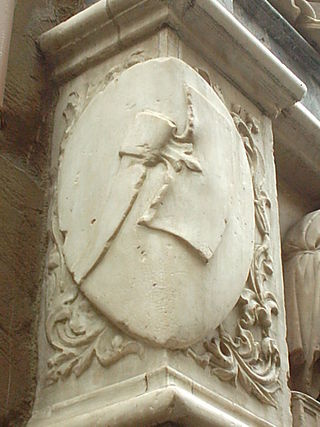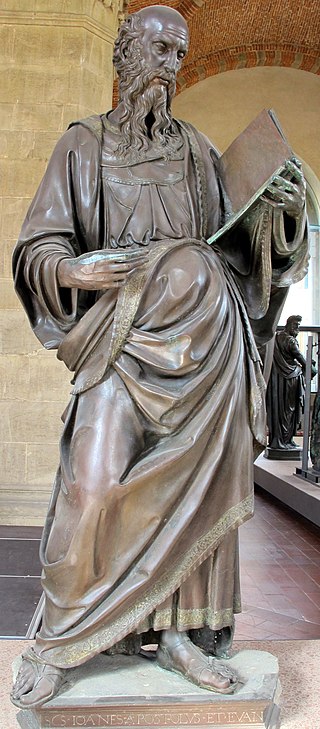
Luca della Robbia was an Italian Renaissance sculptor from Florence. Della Robbia is noted for his colorful, tin-glazed terracotta statuary, a technique that he invented and passed on to his nephew Andrea della Robbia and great-nephews Giovanni della Robbia and Girolamo della Robbia. Although a leading sculptor in stone, after developing his technique in the early 1440s he worked primarily in terracotta. His large workshop produced both less expensive works cast from molds in multiple versions, and more expensive one-off individually modeled pieces.

Domenico di Michelino (1417–1491) was an Italian Renaissance painter who was born and died in Florence. His real name was Domenico di Francesco. The patronymic "di Michelino" was adopted in honour of his teacher, the cassone painter Michelino di Benedetto, by whom no works have been identified. Giorgio Vasari reports that Domenico was also a pupil of Fra Angelico, whose influence is reflected in many of Domenico's paintings along with that of Filippo Lippi and Pesellino.

The Accademia di Belle Arti di Firenze is an instructional art academy in Florence, in Tuscany, in central Italy.
The Ciompi Revolt was a rebellion among unrepresented labourers which occurred in the Republic of Florence, from 1378 to 1382. Those who revolted consisted of artisans, labourers, and craftsmen who did not belong to any guilds and were therefore unable to participate in the Florentine government. These labourers had grown increasingly resentful over the established patrician oligarchy. In addition, they were expected to pay heavy taxes which they could not afford, forcing some to abandon their homes. The resulting insurrection over such tensions led to the creation of a government composed of wool workers and other disenfranchised workers which lasted for three and a half years.

The Frescobaldi are a prominent Florentine noble family that have been involved in the political, social, and economic history of Tuscany since the Middle Ages. Originating in the Val di Pesa in the Chianti, they appear holding important posts in Florence in the twelfth century.

The Arte della Lana was the wool guild of Florence during the Late Middle Ages and in the Renaissance. It was one of the seven Arti Maggiori ("greater trades") of Florence, separate from the Arti Minori and the Arti Mediane (the "middle trades"). The Arte della Lana dealt in woollen cloth and cooperated with the other corporations of bankers and merchants in administering the commune, both under the podestà and the Republic of Florence. The powerful Albizzi family were prominent members of the guild.

The Ospedale degli Innocenti 'Hospital of the Innocents', also known in old Tuscan dialect as the Spedale degli Innocenti, is a historic building in Florence, Italy. It was designed by Filippo Brunelleschi, who received the commission in 1419 from the Arte della Seta. It was originally a children's orphanage. It is regarded as a notable example of early Italian Renaissance architecture. The hospital, which features a nine bay loggia facing the Piazza SS. Annunziata, was built and managed by the "Arte della Seta" or Silk Guild of Florence. That guild was one of the wealthiest in the city and, like most guilds, took upon itself philanthropic duties.

Lorenzo di Bicci was an Italian painter of the Florentine School considered to be one of the most important painters in Florence during the second half of the 14th century. He is believed to have learned his trade from his father, about whom little is known. Lorenzo’s style, as well as that of his contemporaries Jacopo di Cione and Niccolò di Pietro Gerini, was influenced by the artist Andrea di Cione. Lorenzo's paintings made use of bright colors and his compositions avoided complexity. The figures he painted tended to have round faces and were often expressionless. Another one of Lorenzo's distinctive characteristics was his precision of execution. He was known for exceptional talent in drawing, an ability that he put to use at the initial stages of his painting. Unlike many celebrated Florentine artists of this period, Lorenzo mostly received commissions from the country clergy and from the lower-middle-class Florentine guilds. His successors, Bicci di Lorenzo and Neri di Bicci, continued to serve these groups.

The guilds of Florence were secular corporations that controlled the arts and trades in Florence from the twelfth into the sixteenth century. These Arti included seven major guilds, five middle guilds and nine minor guilds. Their rigorous quality control and the political role in the commune that the Arti Maggiori assumed were formative influences in the history of Florence, which became one of the richest cities of late Medieval Europe.

The Arte di Calimala, the guild of the cloth finishers and merchants in foreign cloth, was one of the greater guilds of Florence, the Arti Maggiori, who arrogated to themselves the civic power of the Republic of Florence during the Late Middle Ages. The ascendancy of the Calimala ran from the organization of Florentine guilds, each with its gonfaloniere in the thirteenth century, until the rise of the Medici usurped all other communal powers in the fifteenth century. Their presence is commemorated in the via di Calimala, leading away from the city's Roman forum through the Mercato Nuovo to the former city gate, the Por Santa Maria, as the Roman cardo; the main street, as old as Florence itself, was a prime location for trade, even though, unpaved, crowded, and much narrower than its present state, it was truly a callis malis, an "ill passage-way". The name Calimala is of great antiquity and obscure etymology. Though the original earliest archives of the Arte di Calimala were lost in an 18th-century fire, abundant copies, preserved at the Archivio di Stato, Florence, document the guild's statutes and its activities.

Gonfaloniere of Justice was a post in the government of medieval and early Renaissance Florence. Like Florence's Priori, it was introduced in 1293 when Giano Della Bella's Ordinances of Justice came into force.

Orsanmichele's St. James the Major Tabernacle located on the southern façade of Orsanmichele, in Florence, is the tabernacle of The Guild of Furriers and Skinners. The statue of St. James the Major, by Niccolò di Piero Lamberti, once occupied the niche but is now housed in the Museum of Orsanmichele.
Alessandro Vezzosi is an Italian art critic, Leonardo scholar, artist, expert on interdisciplinary studies and creative museology, he is also the author of hundreds of exhibits, publications and conferences, in Italy and abroad on Leonardo da Vinci and the Renaissance, contemporary art and design. Amongst others, he was the first scholar from the Armand Hammer Centre for Leonardo Studies from the University of California in Los Angeles (1981), directed by Carlo Pedretti; he taught at the University of Progetto in Reggio Emilia; and he is honorary professor at the Accademia delle Arti del Disegno of Florence. He began as an artist from 1964 to 1971 winning more than 80 prizes in painting competitions. In the Seventies he was the founder of the "Archivio Leonardisimi" and of Strumenti-Memoria del Territorio; he coordinated "ArteCronaca", he was the historical-artistic consultant of the Municipality of Vinci and he collaborated on the publications on Tuscany and Leonardo, modern and contemporary art. In 1980 he curated the Centro di Documentazione Arti Visive of the Municipality of Florence.

The Arte dei Maestri di Pietra e Legname was one of the Guilds of Florence that represented the Master stonemasons, woodcarvers, and sculptors. It was founded before 1236, and it came to absorb multiple building crafts in the Florence area. It was one of the five Arti Mediani ("middle trades")

The Palazzo dell'Arte dei Beccai or Residenza dell'Arte dei Beccai is a fourteenth-century building in Florence, Italy. It faces the Orsanmichele, once a grain market, later the church of the guilds of Florence. It has had many occupants, including the Arte dei Beccai or guild of butchers from which its name derives. Since 1974 it has housed the Accademia Fiorentina delle Arti del Disegno, an academy of the arts.

Saint George is a marble sculpture by Donatello. It is one of fourteen sculptures commissioned by the guilds of Florence to decorate the external niches of the Orsanmichele church. St. George was commissioned by the guild of the armorers and sword makers, the Arte dei Corazzai e Spadai.

Saint John the Evangelist is a 2.66 m high bronze statue of John the Evangelist by Baccio da Montelupo, completed in 1515. It was commissioned by the Arte della Seta as part of a cycle of fourteen sculptures for the external niches of Orsanmichele, each showing the patron saint of one of the guilds of Florence. It is now in the Museo di Orsanmichele, although a replica fills its original niche.

Saint Stephen is a 2.6 m high bronze statue of saint Stephen by Lorenzo Ghiberti, completed for the Arte della Lana guild in 1427–28. It is now in the Museo di Orsanmichele, although a replica fills its original niche on the exterior of Orsanmichele, where it was one of a cycle of fourteen sculptures, each showing the patron saint of one of the guilds of Florence.
Saint Peter is a Apuan marble sculpture of Saint Peter of 2.43 m high. It is attributed to Filippo Brunelleschi and his style is influenced by Donatello. It forms part of a cycle of fourteen statues of the patron saints of the guilds of Florence for the external niches of Orsanmichele. The sculpture of St Peter was completed for the Arte dei Beccai (butchers) guild around 1412 and is now in the Museo di Orsanmichele, although a replica fills its original niche.

Saint Louis of Toulouse is a gilded bronze sculpture of Louis of Toulouse by Donatello with a marble niche all'antica on the facade of Orsanmichele, executed in 1423–1425. It is now in the refectory of the Museo di Santa Croce in Florence.

















